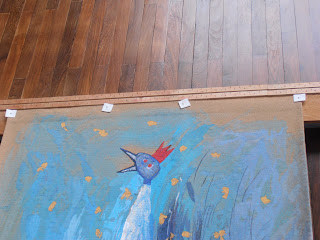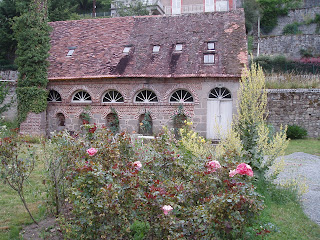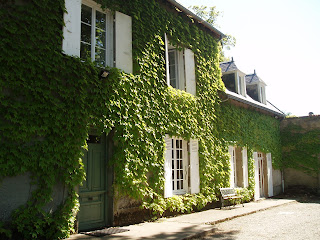On Friday our minibus driver took us to the town of Felletin, to view only one of two viable workshops left in the area, the historic Ateliers Pinton. It happened to be a day off for the tapestry weavers, so unfortunately we did not see them at the loom but this is a workshop run in the traditional manner where they copy the artwork in faithful reproduction from a carefully numbered cartoon. On my first visit we were fortunate to meet and speak with the "cartonniere", an attractive young woman who was sitting on the floor laboriously outlining the areas of colour for the weavers to follow. The designs, by British artist Ahmed Moustafa, were intimidatingly large and complicated but alive with luminous bands of colour enlivened by gold thread. Also destined for the Cite, they will be a stunning addition to the collection.
Cartonnier at work numbering the cartoon
A Moustafa on the loom
Completed tapestry being unrolled
Tissot tapestry nailed up for hanging
Rug tufting studio
Susanne with Leger edition
In the Eglise du Château there was a very interesting exhibition called “Licornes et
bestes etranges” (the S in bêtes is not a spelling mistake but the medieval spelling of the word).
A combination of ancient and contemporary tapestry around the theme of animals, the
unicorn tapestry, Peau de Licorne, that we saw on the loom last year at Patrick Guillot’s workshop being the focus. Designed by Nicolas Buffe, it is displayed as a floor piece and is a contemporary version of the hallowed unicorn, shaped like the flayed skin of the animal complete with Limoges porcelain head and hoofs! Woven in black and white, the design is incredibly complex with highly detailed vignettes throughout, which, when observed closely draw inspiration from amongst other things, Japanese Manga cartoons. Old and new combined in an absolute collision of ideas. Patrick's hands flew deftly over these finest of details and we learned a new stitch (derived from Soumak, I think) that outlined beautifully the most delicate forms.
We then boarded our bus and headed to Aubusson for our last visit there. Our first stop was to meet Patrick Guillot who was working in the ENSA building on a large commission for a Government building that is decorated in 18th C. style. Patrick was quite effusive and talked at length about his contribution as creative collaborator on the project. The design was an unusual amalgam of fruit, flowers, shells and story book creatures cavorting on a background that mimicked a pattern of green moire silk. Ribbons of text also wound their way around the subjects. The loom was warped in two different warp settings with some very closely spaced bands of warp inserted to cope with the fine detail. Patrick's skill is consummate as he interprets the impossibly difficult work with alarming speed.
The re-invigorated tapestry school has produced its first batch of ten graduates and we briefly viewed their samplers and projects that were on view in another building. It was great to see the budding future of a real tapestry revival in a town that is synonymous with this craft.
Exhibition in Eglise du Château
Peau de Licorne with Limoges porcelain hoofs and horn
Peau de Licorne being woven
Other works in the exhibition included a conceptual piece by Bernard Battu and the artist Jacques Harambaru. It comprised a large "filet"net hung from the wall, weighted shells and rocks caught in its folds. An embroidered needlepoint three dimensional unicorn dragged a male torso in its wake, quite bizarre and very brightly coloured. A very curious inclusion was a cartoon for La Dame a la Licorne, dating from the 1940s and ostensibly created for the weaving of editions, upon which the little animals were pasted on separate pieces of paper for ease of shifting them around.
Needlepoint Unicorn
Painted cartoon with animal cut outs
We then boarded our bus and headed to Aubusson for our last visit there. Our first stop was to meet Patrick Guillot who was working in the ENSA building on a large commission for a Government building that is decorated in 18th C. style. Patrick was quite effusive and talked at length about his contribution as creative collaborator on the project. The design was an unusual amalgam of fruit, flowers, shells and story book creatures cavorting on a background that mimicked a pattern of green moire silk. Ribbons of text also wound their way around the subjects. The loom was warped in two different warp settings with some very closely spaced bands of warp inserted to cope with the fine detail. Patrick's skill is consummate as he interprets the impossibly difficult work with alarming speed.
Patrick showing Susanne the project on the loom
The cartoon hanging down behind the loom
A walk through the old town brought us to the atelier and shop of Chantal Chirac, perched on the side of the river on the Pont de la Terrade, and stuffed with the most amazing array of artwork and furniture which seems to cheerily overflow from the constraints of its surrounds. She restores old tapestry cartoons and we observed roll upon roll of them, mostly 18th C. designs in full colour from which exact copies would have been made in tapestry. A large building next door has been built in sympathetic style to house a private cartoon museum. The charming Musee des Cartonnes has been skilfully designed with views out to the river, and is comprised of four or five rooms of painted cartoons from the last three centuries in an interesting display. A downstairs area exhibited a retrospective of tapestries designed by Antonia Bory, who is now in her nineties. Chantal's husband Bernard treated us to an amusing overview as he grappled valiantly with English translations of his very French expressions.
And so back to the Manoir on our minibus, and our final dinner cooked by the lovely Valerie. Susanne joined us for a delicious farewell dinner of delicate coquilles St. Jacques, one of the most classic French dishes. There was much happy chatter, giving of gifts and very emotional goodbyes. My fondest wish is to return in 2013. Our meals were so special that I have listed Valerie's menus here.
Valerie's Menus
Filet mignon of pork cooked with sage - fresh pasta - pear tart with caramel sauce
Filet mignon sauté à la sauge –pâtes fraiches- flan poires sauce caramel
Poached fish – vegetables - crumble
Poisson poché – julienne de légumes –crumble
Marinated chicken with a confit of ratatouille - white chocolate and raspberry dessert
Poulet mariné -confit de ratatouille-verrine chocolat blanc framboises
Vegetable lasagna – salad - cooked pears with spices
Lasagne de légumes-salade-poires aux épices.
Roast beef – vegetables - poached fruit with ice cream
Roti de bœuf-légumes-fruits pochés –glace.
Spring lamb casserole - mango carpaccio with spices
Navarin d’agneau printanier-carpaccio de mangue aux épices douces.
Scallops with a fondue of leeks - baked peaches with pistachio and speculoos
Saint-jacques-fondue de poireaux-pêches rôties pistache spéculoos
The next morning we tidied up and packed our bags. Francois came over to say goodbye and I promised I would be back. Our coach appeared beyond the hedges and swept us off through the picturesque countryside to Limoges and our train to Paris.
Chantal Chirac's studio with new Musee des Cartonnes on the right.
Studio interior
Valerie's Menus
Filet mignon of pork cooked with sage - fresh pasta - pear tart with caramel sauce
Filet mignon sauté à la sauge –pâtes fraiches- flan poires sauce caramel
Poached fish – vegetables - crumble
Poisson poché – julienne de légumes –crumble
Marinated chicken with a confit of ratatouille - white chocolate and raspberry dessert
Poulet mariné -confit de ratatouille-verrine chocolat blanc framboises
Vegetable lasagna – salad - cooked pears with spices
Lasagne de légumes-salade-poires aux épices.
Roast beef – vegetables - poached fruit with ice cream
Roti de bœuf-légumes-fruits pochés –glace.
Spring lamb casserole - mango carpaccio with spices
Navarin d’agneau printanier-carpaccio de mangue aux épices douces.
Scallops with a fondue of leeks - baked peaches with pistachio and speculoos
Saint-jacques-fondue de poireaux-pêches rôties pistache spéculoos
































































